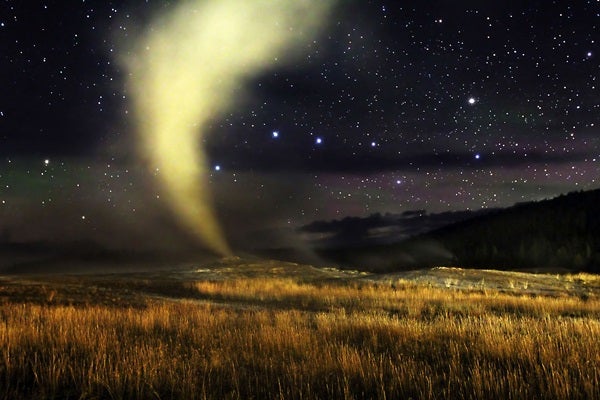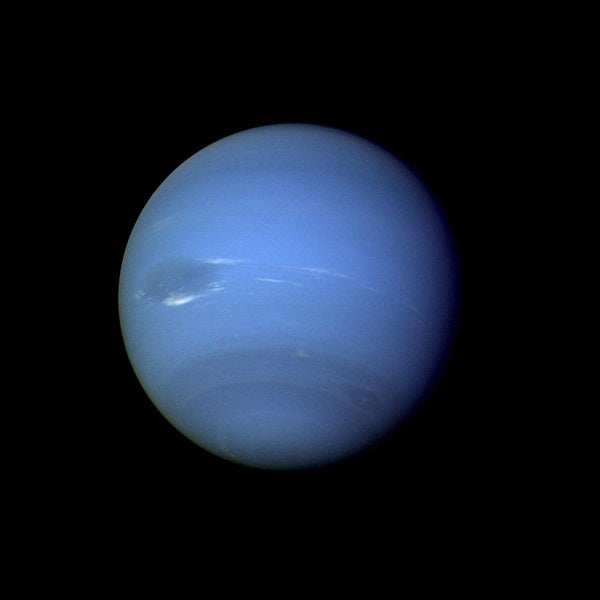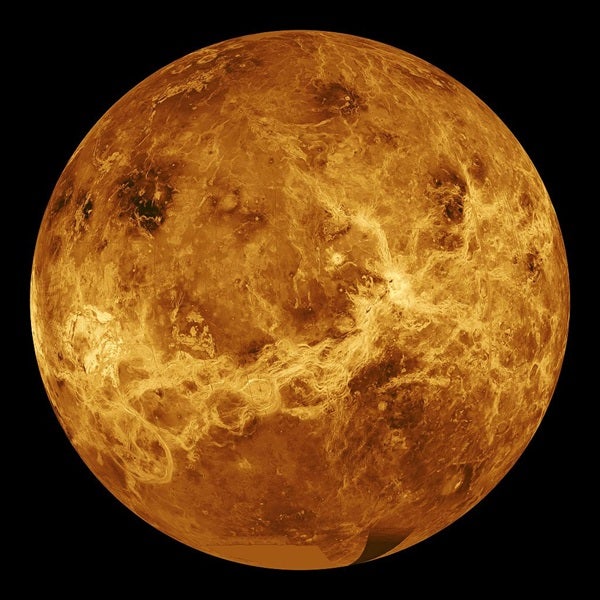Friday, May 26
Although the Moon passed nearly between the Sun and Earth yesterday, it reappears as a slender crescent in this evening’s sky. Scan just above the west-northwestern horizon with binoculars about a half-hour after sunset. The Moon then stands 5° (less than a typical binocular field) high. You also should see Mars some 5° to Luna’s upper right. Unfortunately, Mars’ days as an evening object are dwindling to a precious few. The magnitude 1.7 Red Planet appears only in twilight and dips below the horizon before 10 p.m. local daylight time.
Saturday, May 27
Saturn offers a visual treat all week. The ringed planet rises before 10 p.m. local daylight time and climbs some 30° above the southern horizon by 2 a.m. Shining at magnitude 0.1, Saturn is easily the brightest object in the constellation Ophiuchus. When viewed through a telescope this week, the gas giant world shows an 18″-diameter disk surrounded by a spectacular ring system that spans 41″ and tilts 27° to our line of sight.
Sunday, May 28
Look high in the northwest after darkness falls this week and you’ll be greeted by the familiar sight of the Big Dipper. The Dipper is the sky’s most conspicuous asterism — a recognizable pattern of stars that doesn’t form a complete constellation shape. It makes up the body and tail of Ursa Major the Great Bear. Use the Pointers, the two stars at the end of the Dipper’s bowl, to find Polaris, which lies due north for everyone north of the equator. Polaris marks the end of the Little Dipper’s handle. On evenings in late May, the relatively faint stars of this dipper arc directly above Polaris.
Monday, May 29
You should be able to catch a glimpse of Mercury in the predawn sky early this week. The innermost planet lies 5° above the eastern horizon 30 minutes before sunrise. Glowing at magnitude –0.2, Mercury should stand out through binoculars if you have an uncluttered horizon. A telescope reveals the planet’s 7″-diameter disk, which appears 60 percent illuminated.
Tuesday, May 30
Jupiter appears halfway to the zenith in the southern sky during twilight this week and doesn’t set until around 3 a.m. local daylight time. The brilliant planet shines at magnitude –2.3 among the background stars of Virgo, some 10° northwest of the Maiden’s brightest star, 1st-magnitude Spica. When viewed through a telescope, Jupiter’s disk spans 41″ and shows a wealth of detail in its massive atmosphere.
Wednesday, May 31
Neptune rises around 2 a.m. local daylight time and appears about 20° above the southeastern horizon as twilight commences. The distant world glows at magnitude 7.9, so you’ll need binoculars or a telescope to spot it. Fortunately, it lies near a brighter star that will guide you. This morning, Neptune stands 13′ southeast of 6th-magnitude 81 Aquarii. The star shines some five times brighter than the planet. You can confirm your sighting of Neptune through a telescope, which reveals the planet’s 2.3″-diameter disk and blue-gray color.
Thursday, June 1
First Quarter Moon occurs at 8:42 a.m. EDT. The half-lit orb rises around 1 p.m. local daylight time, appears highest in the south shortly before sunset, and sets around 2 a.m. The Moon spends this evening among the background stars of southern Leo the Lion.
Friday, June 2
Brilliant Venus rises in the east around 3:30 a.m. local daylight time. Although stunning in its own right, Venus serves as a guide to distant Uranus. The outer planet lies within 2° of its bright neighbor for the next three mornings. Target Venus with your binoculars and imagine it as the center of a clock’s face. You’ll find Uranus at the 10 o’clock position this morning, at 11 o’clock tomorrow, and at 12 o’clock on the 4th. You’ll need to look closely to spot magnitude 5.9 Uranus, which glows some 10,000 times fainter than Venus.
Saturday, June 3
Venus lies 46° west of the Sun today, its greatest elongation during this morning apparition. It rises approximately two hours before sunrise and appears brilliant in the east before dawn. The planet shines at magnitude –4.4 and stands nearly 15° above the horizon an hour before sunrise. When viewed through a telescope this morning, Venus’ disk spans 24″ and appears half-lit.
The waxing gibbous Moon passes 2° north of Jupiter this evening. The pair dominates the sky from shortly after sunset until well past midnight
Sunday, June 4
Comet Johnson (C/2015 V2) should glow at 6th magnitude this week, bright enough to see through binoculars or a small telescope despite the Moon’s presence. It rides high in the south during late evening in the company of magnitude 0.0 Arcturus. The comet appears 5° east of the star both last night and tonight. This first-time visitor to the inner solar system makes its closest approach to Earth on June 5 and comes closest to the Sun just one week later.












